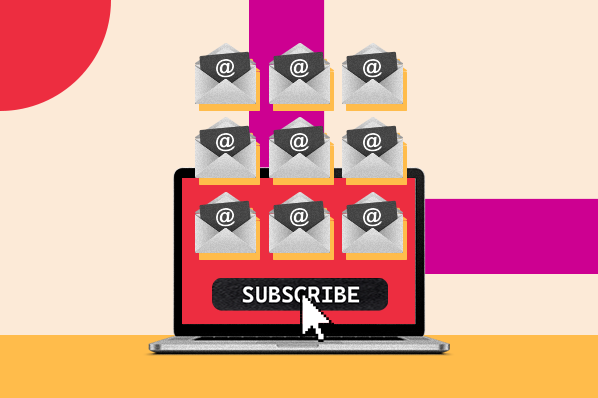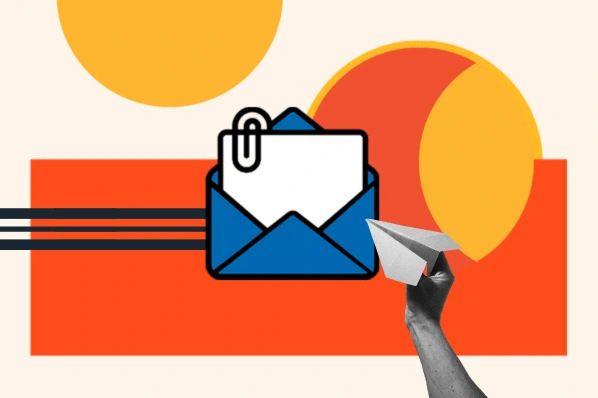Yes, thousands of contacts are a credit card swipe away, but your email marketing program — a critical part of a well-rounded inbound marketing strategy — can seriously suffer. Curious why buying email lists is a legitimate email marketer's kiss of death? Read on.
Plus, we'll give you a list of squeaky-clean and effective ways to build your email marketing list without simply buying one.
Methods of Acquiring an Email List
Before we get into the pitfalls of buying email addresses, let's review three ways marketers are currently able to acquire their email lists:
1. Buy an email list.
You work with a list provider to find and purchase a list of names and email addresses based on demographic and/or psychographic information. For example, you might purchase a list of 50,000 names and email addresses of people who live in Minnesota and don't have children. There are several sustainable ways to use email marketing to grow your business. This isn't one of them.
2. Rent an email list.
Also working with a list provider, you identify a segment of people to email — but you never actually own the list. As such, you can't see the email addresses of the people you're emailing, so you must work with the provider to send out your email.
3. Own an opt-in email list.
Someone voluntarily gives you their email address either online or in-person so you can send them emails. They may pick certain types of email content they wish to receive, like specifically requesting email alerts when new blog posts are published. Opt-in email addresses are the result of earning the interest and trust of your contacts because they think you have something valuable to say.
When it comes to rented or purchased lists, you may come across vendors or marketers who say, "This email list is totally opt-in!" This means the people on the list opted in to email communication from someone at some point in time — the list provider, for example — by filling out a form or checking a box to receive more content from that provider.
What "opt-in" lists don't mean, however, is that email recipients opted in to receive email communications from your business. This is a critical distinction, and the next section of this post will go into more detail on why this type of "opt-in email list" (should be read with air quotes) is not a good idea for your email marketing program.
1. You'll violate the rules of consent under GDPR.
Most email marketers around the world are legally required to allow recipients to opt out of emails they no longer want to receive. Contacts must be able to do this directly in the email message. The General Data Protection Regulation (GDPR), a European data privacy act that doubles down on the opt-in side of this relationship — and found that purchased email lists are simply not compliant.
GDPR has revamped numerous aspects of a digital marketer's use of customer data throughout Europe — on a website, in social media, and via email. You don't even have to work in Europe to fall under the act's jurisdiction; if your recipients live in Europe, they're protected by GDPR.
With GDPR now governing all email correspondence across Europe, adding an opt-out option to your email template no longer cuts it. Under this act, you must have explicit consent from your contacts to send them emails. Explicit, in this case, means the checkbox a person must click to opt into an email subscription isn't pre-checked when they see it on your website. And when you buy your email lists, the people on it haven't been given this option — making you non-compliant with GDPR before you send your first email.
Want some non-legal reasons to avoid the purchased email list? We've got those as well, below.
2. Reputable email marketing services don't let you send emails to lists you've bought.
If you're using email marketing software or plan to in the future, you'll find that reputable companies will insist that you use opt-in email lists. You might be saying, "I'll just use a non-reputable email marketing vendor."
Alas, ESPs on shared IP addresses that don't require customers to use opt-in email lists typically suffer poor deliverability. Why? One customer's ill-gotten email address list can poison the deliverability of the other customers on that shared IP address. You're going to want to hitch your wagon to the light side of the email marketing force if you want your emails to actually get into inboxes.
3. Good email address lists aren't for sale.
Unless your company is in the middle of a merger or acquisition, you're not going to come across a high-quality email list you can purchase. If it's for sale, it means the email addresses on it have already been deemed non-responsive or unqualified for marketing outreach.
While bought email addresses might've at one time had value, they've likely been spammed to the ends of the earth — otherwise, they'd still be in the desiring hands of the company selling them. Think about it, would you sell or share the email addresses of those who have voluntarily opted in to receive email from you?
4. People on a purchased or rented list don't know you.
I referenced this earlier, but it's worth going into some more detail on this subject. Rented and purchased lists are sometimes scraped from other websites, which, I think we can all agree, is a dirty way to acquire email marketing contacts.
But let's say the email addresses you're looking to purchase were not taken from another site but rather earned legitimately. Email list purchase and rental companies might tout that those lists are "opt-in." Sounds great, right?
Not really. Email addresses that belong to an "opt-in" list have opted to receive emails from, say, the list-purchasing company — not your company. Even if the opt-in process includes language like, "Opt-in to receive information from us, or offers from other companies we think you might enjoy," the fact is the recipient doesn't recall having a prior relationship with you, specifically. This makes it highly likely for the recipients to mark you as "spam" when you arrive in their inboxes. Hey, if they don't recognize you or remember opting into communications from you ... can you blame them?
After all, the most prevalent type of spam is advertising-related email — accounting for approximately 36% of all spam messages.
This takes us to our next point.
5. You'll harm your email deliverability and IP reputation.
Did you know there are organizations dedicated to combating email spam? Thank goodness, right? They set up a little thing called a honeypot, which is a planted email address that, when harvested and emailed, identifies the sender as a spammer. Similarly, things called spam traps can be created to identify spammy activity; they're set up when an email address yields a hard bounce because it's old or no longer valid, but still receives consistent traffic. Fishy, eh?
As a result, the email address turns into a spam trap that stops returning the hard bounce notice, and instead accepts the message and reports the sender as a spammer.
If you purchase a list, you have no way of confirming how often those email addresses have been emailed, whether the email addresses on that list have been scrubbed for hard bounces to prevent identifying you as a spammer, or from where those email addresses originated.
Are you really willing to risk not only your email deliverability, but also the reputation of your IP address and your company? Even if you find the light after purchasing or renting email lists and decide to only email those who have opted in with your company, it'll take you months (or maybe years) to get your Sender Score up and rebuild the reputation of your IP.
6. You can come across as annoying.
How do you like it when you get an email in your inbox from a company you've never heard of? I bet that's not the kind of company you want to buy from or work for.
If someone didn't ask to hear from you, it doesn't mean they won't want to hear from you later. It's your job to prove to them — through helpful content and valuable offers — that they should stay up to date with your company via email. If you force your email content on anyone too early, even if you know in your bones they're a great fit for your products or services, you risk preemptively losing their trust and their future business.
7. Your email service provider can penalize you.
Buying email lists doesn't just damage your deliverability and brand reputation — it can also put your email account at risk. Email clients like Gmail, Yahoo!, and Outlook don't want to be associated with accounts that recipients repeatedly flag as spam. Email service providers like AWeber go as far as immediately closing your account if it suspects you're sending unwanted content.
If these consequences are too daunting, we came up with some alternatives to paid email lists that’ll gain your customers’ interests.
Paid Email List Alternatives
1. Shift your outbound marketing strategy to inbound.
Buying email lists is another form of outbound marketing — it’s the method that pushes messaging out to potential customers. Not only is it costly, but it doesn’t guarantee a higher ROI as a result.
When you shift your strategy to inbound marketing, you’re repositioning your business to build brand awareness and customer relationships through content creation and social media tactics.
2. Conduct lead generation campaigns.
Lead generation is the process of attracting prospects to your business and nurturing their interests with the goal of making them into customers. This can be achieved through effective marketing campaigns with enticing call-to-actions.
Some examples of lead gen campaigns include:
- Sharing blog posts with informational content
- Promoting product offerings across social media channels
- Offering product trials or coupons that lead to your landing page
Your business can get creative with campaigns to better engage your audience, especially with our next point in mind.
3. Show thought leadership through your content.
With the content your business shares to an audience, you have the ability to display thought leadership. This tactic is used in content marketing to build trust and gain credibility in your field.
To become a thought leader, your business needs to display brand helpfulness through informative content like tutorials, listicles, and other posts that help your target audience learn something new.
If you want to use both email marketing while implementing these alternatives, read on to see how to do it right.
How to Grow an Opt-In Email List for Free
Now that you've learned a few ways to acquire email lists, let's explore how you can acquire them through the third method stated earlier in this article — the opt-in method.
Generating your own list of email contacts who have opted in to receive content from you doesn't just comply with legal regulations and protect your brand reputation. It also presents you with opportunities to grow this list through genuine relationships with new customers. We've already written about clever ways to go about doing this, which you can check out here. But, below are the basic best practices that have a very big bang for their buck when it comes to consistently growing an email list.
1. Create gated assets so there's a reason for people to give you their email address.
Webinars, ebooks, templates, etc. — these are all good long-form, premium content assets that people may find valuable enough to give over their email address. The more gated assets you have to put behind landing pages, the better — a wider variety of content will make it easier for you to attract a wider swath of people.
2. Create useful tools.
If ebooks aren't your jam, create tools instead. I don't recommend a one-or-the-other approach, but if you have more development talent than writing talent, this may be a more attractive option for you. These tools can be valuable enough to some of your website visitors that they'll trade you their email address for a free demo of the product you built. Then, for your first email, ask them what they thought of the tool. It's the perfect icebreaker.
For example, we created Website Grader — which is free to use, but prompts you to input an email address. We also took a similar approach to a more recent tool, the Blog Topic Generator.
3. Promote those gated assets on your marketing channels.
Now that you have some gated assets that can capture email addresses, spend a considerable amount of time making sure the world knows about them. You have plenty of channels at your disposal — social media, PPC, and email are common ones to turn to. But, none will provide lasting returns quite like your blog. Consider this scenario:
You promote your new gated assets by blogging about subject matters related to the content assets you've created. Put CTAs that lead to the asset's landing page on every one of those blog posts.
Now let's say your blog posts get about 100 views per month, and your visitor-to-lead conversion rate on the blog is about two percent. That means you'd get two leads from a single blog post each month.
Then, let's say you write 30 blog posts a month. That means you'd get 60 leads in a month — two from each blog post. Now keep doing that for a year. The work you did to blog that first month will continue to drive leads throughout the year. That means you're actually getting 4,680 opt-in contacts a month by the end of 12 months because of the compounding effects of blogging — not just 720 opt-in contacts (60 leads*12 months).
-1.webp?width=624&height=312&name=Why%20Buying%20Email%20Lists%20Is%20Always%20a%20Bad%20Idea%20(And%20How%20to%20Build%20Yours%20for%20Free)-1.webp)
4. Run creative email marketing campaigns.
Most people don't think of email as a lead- or contact-generating channel. But because people forward helpful emails to colleagues or friends, it can expand your database if you simply make forwarding or sharing email content easy for recipients. Include calls-to-action in your emails that make sharing an obvious choice for recipients, particularly with your most useful assets.
If you already have a pretty large database, you also likely have some contacts that have gone quite stale. If so, I recommend running a re-engagement campaign that can help you both scrub your email list and prevent the kind of spam and IP issues I addressed earlier, as well as reawaken old contacts that might have forgotten about you, but would actually be great fits for sales.
5. Include sharing buttons in your emails.
Consider adding share buttons to your email so your email recipients can forward the emails they liked most to friends and colleagues they think would like it, too.
Have a few different buttons on your email template: separate social media buttons that produce pre-written social posts linking to a webpage version of your email, and an "Email to a Friend" button that transfers the email into a compose window so your contacts can instantly forward the message. Just make sure your email has an opt-in button so each new viewer can subscribe to more emails from you if they like what they see.
Attract Customers without Breaking the Bank
There’s already plenty of noise your business has to break through to get to your customers — so don’t let your paid email marketing efforts end in their spam box. Instead, we hope you use this article to devise a strategy to attract prospects with impressive content, assets, and tools that nurture them from leads to customer advocates.
This article was originally published in July 2018 and has been updated for comprehensiveness.
Email Lists and Segmentation
.png?width=112&height=112&name=Image%20Hackathon%20%E2%80%93%20Vertical%20(84).png)

.png)




.jpg)





